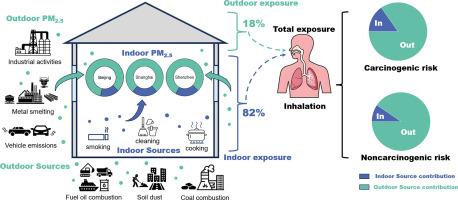中国特大城市室内/室外居住建筑中与 PM2.5 结合的元素的来源分配和健康风险评估
IF 7.1
1区 工程技术
Q1 CONSTRUCTION & BUILDING TECHNOLOGY
引用次数: 0
摘要
室内环境中直径为 2.5 μm 或更小的颗粒物(PM2.5)来源于室内和室外,通过不同的成分影响相关的人类健康风险。本研究同时收集和分析了中国三个主要特大城市--北京、上海和深圳的室内和室外 PM2.5 样本,以确定 PM2.5 的来源特征并评估其对健康的影响。研究发现,PM2.5 共有七种不同的室内和室外来源:室内活动、金属冶炼、工业活动、土壤扬尘、汽车尾气排放、燃煤和燃油燃烧。室内活动约占住宅室内 PM2.5 的 20%,其余主要是室外 PM2.5 的渗入。室内活动对非致癌和致癌风险的贡献率从 3.6% 到 28.5% 不等,而室外 PM2.5 来源对健康的风险更大。北京、上海和深圳成人的累积非致癌风险分别为 0.99、1.15 和 0.72,略高于儿童。成人的累积致癌风险约为儿童的五倍,分别为 6.90 × 10-5、6.34 × 10-5 和 6.83 × 10-5,均超过了可接受限值。非致癌风险主要来自于镍、钴和锰,占总风险的 85%以上,而铬则是致癌风险的主要来源(89%)。室内环境暴露占成人非致癌和致癌风险的 80% 以上,占儿童非致癌和致癌风险的 90% 以上。这项研究从源头角度为有效控制 PM2.5 污染和降低健康风险提供了重要启示。本文章由计算机程序翻译,如有差异,请以英文原文为准。

Source apportionment and health-risk assessment of PM2.5-bound elements in indoor/outdoor residential buildings in Chinese megacities
Particulate matter with a diameter of 2.5 μm or smaller (PM2.5) in indoor environments originates from both indoor and outdoor sources, influencing associated human health risks through different compositions. This study simultaneously collected and analyzed indoor and outdoor PM2.5 samples in three major Chinese megacities—Beijing, Shanghai, and Shenzhen—to characterize PM2.5 sources and assess their health impacts. A total of seven distinct sources, both indoor and outdoor, were identified for PM2.5: indoor activities, metal smelting, industrial activities, soil dust, vehicle emissions, coal combustion, and fuel oil combustion. Indoor activities accounted for approximately 20 % of the residential indoor PM2.5, with the remainder predominantly due to outdoor PM2.5 infiltration. The contributions of indoor activities to noncarcinogenic and carcinogenic risks ranged from 3.6 % to 28.5 %, whereas outdoor PM2.5 sources posing greater health risks. The cumulative noncarcinogenic risks for adults in Beijing, Shanghai, and Shenzhen were 0.99, 1.15, and 0.72, respectively, slightly higher than those for children. The cumulative carcinogenic risks for adults were approximately five times those for children, with values of 6.90 × 10−5, 6.34 × 10−5, and 6.83 × 10−5, respectively, all surpassing the acceptable limit. Noncarcinogenic risks were predominantly attributed to Ni, Co, and Mn, contributing over 85 % to the total risk, while Cr was the primary contributor (>89 %) to carcinogenic risks. Indoor environmental exposure accounting for over 80 % of noncarcinogenic and carcinogenic risks for adults, and exceeding 90 % for children. This study provides significant insights into the effective control of PM2.5 pollution and the reduction of health risks from a source perspective.
求助全文
通过发布文献求助,成功后即可免费获取论文全文。
去求助
来源期刊

Building and Environment
工程技术-工程:环境
CiteScore
12.50
自引率
23.00%
发文量
1130
审稿时长
27 days
期刊介绍:
Building and Environment, an international journal, is dedicated to publishing original research papers, comprehensive review articles, editorials, and short communications in the fields of building science, urban physics, and human interaction with the indoor and outdoor built environment. The journal emphasizes innovative technologies and knowledge verified through measurement and analysis. It covers environmental performance across various spatial scales, from cities and communities to buildings and systems, fostering collaborative, multi-disciplinary research with broader significance.
 求助内容:
求助内容: 应助结果提醒方式:
应助结果提醒方式:


